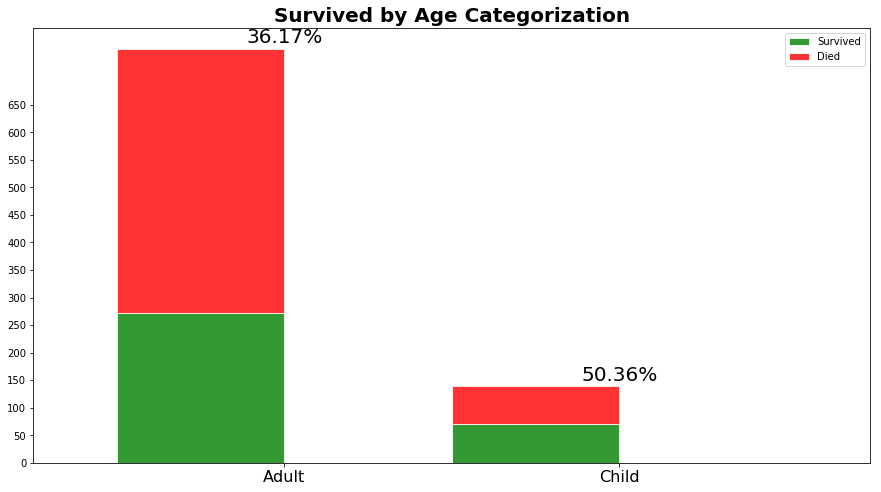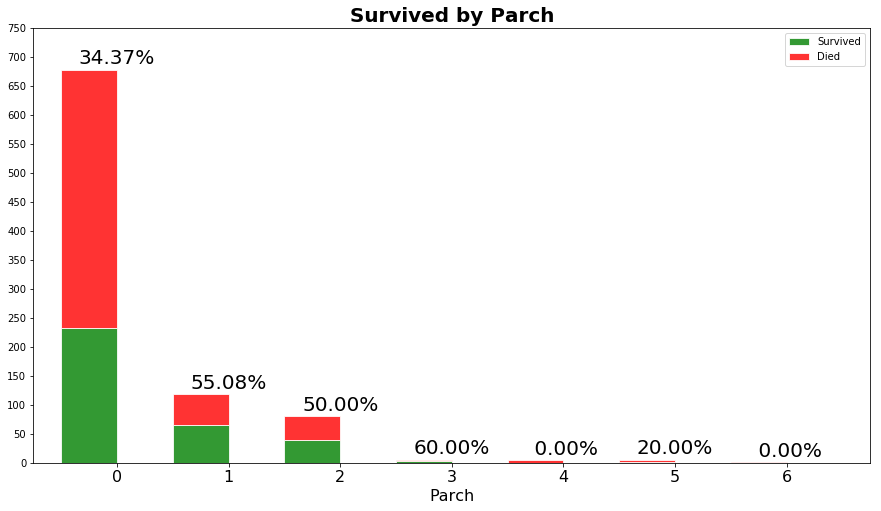
之前用学生证在graphlab上申了一年的graphlab使用权(华盛顿大学机器学习课程需要)然后今天突然想到完全可以用这个东东来参加kaggle.
下午参考了一篇教程,把notebook上面的写好了
本文很多代码参考了turi官网的一个教程,有兴趣的同学可以去看原版 https://turi.com/learn/gallery/notebooks/who_survived_the_titanic.html
代码
import graphlab as gl %matplotlib inline import matplotlib.pyplot as mpl mpl.rcParams['figure.figsize']=(15.0,8.0) import numpy as np
第一步:数据探索
导入数据
train = graphlab.SFrame.read_csv('train.csv')
数据探索与数据可视化
#看看除了Survived这一列以外其他列的缺值情况 columns = ("Pclass", "Name", "Sex", "Age", "SibSp", "Parch", "Ticket", "Fare", "Cabin", "Embarked") not_null=[sum(1 for el in train[column] if el or el == 0)for column in columns] null = [len(train) - el for el in not_null] #数字指代第几列 indexes = np.arange(len(columns)) width = 0.5 #用柱形图表示缺值情况 not_null_bar = mpl.bar(indexes, not_null, width, color='green', edgecolor='white', alpha=0.8)#非空为绿,底色为白 null_bar = mpl.bar(indexes, null, width, color='red', edgecolor='white', bottom=not_null, alpha=0.8)#空值为红,底色为白 mpl.xlim( indexes[0] - 0.5, indexes[-1] + 1)#横轴的范围 #柱形图标题 mpl.title('Null values for each column', fontsize=20, weight='bold') #x轴单位长度 mpl.xticks(indexes + width/2., columns, fontsize=16) #y轴单位长度 mpl.yticks(np.arange(0,1200,100)) #右上角为图例 mpl.legend( (not_null_bar[0], null_bar[0]), ('Not Null', 'Null') )

观察上图我们知道Age列有少量缺值,Cabin列有大量的缺值,于是我们需要补全Age缺值,但是把Cabin列整个忽略
直接用Age的均值补全空值
train = train.fillna('Age',train['Age'].mean()) #看看除了Survived这一列以外其他列的缺值情况 columns = ("Pclass", "Name", "Sex", "Age", "SibSp", "Parch", "Ticket", "Fare", "Cabin", "Embarked") not_null=[sum(1 for el in train[column] if el or el == 0)for column in columns] null = [len(train) - el for el in not_null] #数字指代第几列 indexes = np.arange(len(columns)) width = 0.5 #用柱形图表示缺值情况 not_null_bar = mpl.bar(indexes, not_null, width, color='green', edgecolor='white', alpha=0.8)#非空为绿,底色为白 null_bar = mpl.bar(indexes, null, width, color='red', edgecolor='white', bottom=not_null, alpha=0.8)#空值为红,底色为白 mpl.xlim( indexes[0] - 0.5, indexes[-1] + 1)#横轴的范围 #柱形图标题 mpl.title('Null values for each column', fontsize=20, weight='bold') #x轴单位长度 mpl.xticks(indexes + width/2., columns, fontsize=16) #y轴单位长度 mpl.yticks(np.arange(0,1200,100)) #右上角为图例 mpl.legend( (not_null_bar[0], null_bar[0]), ('Not Null', 'Null') )

我们看看Pclass与生存率的关系
passenger_class = train["Pclass"].astype(str) #观察每个Pclass的存活率 #用groupby方法 class_distribution = train.groupby(["Pclass", "Survived"], {'count':gl.aggregate.COUNT()}) #用0和1过滤出生存和死亡 survived = class_distribution.filter_by(1,'Survived').sort("Pclass") died = class_distribution.filter_by(0,'Survived').sort("Pclass") width = 0.5 #柱形图的参数 survived_bar = mpl.bar(survived["Pclass"], survived["count"], width, color='green', edgecolor='white', alpha=0.8) died_bar = mpl.bar(died["Pclass"], died["count"], width, color='red', edgecolor='white', bottom=survived["count"], alpha=0.8) mpl.xlim( indexes[0] - 0.5, indexes[-1] + 1) mpl.title('Survived by Passengers Class', fontsize=20, weight='bold') mpl.xticks(survived["Pclass"] + width/2., survived["Pclass"], fontsize=16) mpl.xlim(0.5,4) mpl.yticks(np.arange(0,600,50)) mpl.legend( (survived_bar[0], died_bar[0]), ('Survived', 'Died') ) for ind in np.arange(len(survived)): ind = int(ind) x = 1 + ind + width / 2. y = survived["count"][ind] + died["count"][ind] + 10 percentage = survived["count"][ind] / float( survived["count"][ind] + died["count"][ind]) * 100 mpl.text(x, y, "%5.2f%%" % percentage, fontsize=20, ha='center')

由此可见,Pclass的存活率从1到3逐次下降
我们看看性别与生存率的关系
sex_distribution = train.groupby(["Sex", "Survived"], {'count':gl.aggregate.COUNT()}) survived = sex_distribution.filter_by(1,'Survived').sort("Sex") died = sex_distribution.filter_by(0,'Survived').sort("Sex") indexes = np.arange(len(survived["Sex"])) width = 0.5 survived_bar = mpl.bar(indexes, survived["count"], width, color='green', edgecolor='white', alpha=0.8) died_bar = mpl.bar(indexes, died["count"], width, color='red', edgecolor='white', bottom=survived["count"], alpha=0.8) mpl.xlim( indexes[0] - 0.5, indexes[-1] + 1) mpl.title('Survived by Sex', fontsize=20, weight='bold') survived["Sex"] = [sex.capitalize() for sex in survived["Sex"]] mpl.xticks(indexes + width/2., survived["Sex"], fontsize=16) mpl.xlim(-0.5,2) mpl.yticks(np.arange(0,700, 50)) mpl.legend( (survived_bar[0], died_bar[0]), ('Survived', 'Died') ) for ind in indexes: ind = int(ind) x = ind + width / 2. y = survived["count"][ind] + died["count"][ind] + 10 percentage = survived["count"][ind] / float( survived["count"][ind] + died["count"][ind]) * 100 mpl.text(x, y, "%5.2f%%" % percentage, fontsize=20, ha='center') mpl.show()

我们看看年龄与生存率的关系
为了更加直观的体现成人与小孩的区别,我再增加一个"Categorized_Age"列
我们使用apply方法来对每个元素进行作用,小于18岁称为小孩,其余均为大人。
#增加列,18以下称为child train['Categorized_Age'] = train['Age'].apply(lambda x: "Child" if x <= 18 else "Adult") #用groupby方法把二者关联 age_distribution = train.groupby(["Categorized_Age", "Survived"], {'count':gl.aggregate.COUNT()}).dropna() #过滤数据 survived = age_distribution.filter_by(1,'Survived').sort("Categorized_Age") died = age_distribution.filter_by(0,'Survived').sort("Categorized_Age") #柱形图参数设置 indexes = np.arange(len(survived["Categorized_Age"])) width = 0.5 survived_bar = mpl.bar(indexes, survived["count"], width, color='green', edgecolor='white', alpha=0.8) died_bar = mpl.bar(indexes, died["count"], width, color='red', edgecolor='white', bottom=survived["count"], alpha=0.8) mpl.xlim( indexes[0] - 0.5, indexes[-1] + 1) mpl.title('Survived by Age Categorization', fontsize=20, weight='bold') survived["Categorized_Age"] = [sex.capitalize() for sex in survived["Categorized_Age"]] mpl.xticks(indexes + width/2., survived["Categorized_Age"], fontsize=16) mpl.xlim(-0.5,2) mpl.yticks(np.arange(0,700, 50)) mpl.legend( (survived_bar[0], died_bar[0]), ('Survived', 'Died') ) for ind in indexes: ind = int(ind) x = ind + width / 2. y = survived["count"][ind] + died["count"][ind] + 10 percentage = survived["count"][ind] / float( survived["count"][ind] + died["count"][ind]) * 100 mpl.text(x, y, "%5.2f%%" % percentage, fontsize=20, ha='center') mpl.show()

由上图可知,未成年人的存活率远大于成人
我们看看家眷人数与生存率的关系
下面的代码算出了家眷人数与生存率的关系。第一个for循环(line 6)是画图需要,遍历分组完生存率的各个家庭,若某个规模的所有家庭没有人生存,还是要加上一列。事实上,bar方法(line 12,13) 希望在每一个家庭规模都要对应的生存率,但是有5或者8个家眷的家庭都gg了。因此,我们用append方法 (line 8) 增加了两列,生存率记为0。
sibling_spouses = train["SibSp"].astype(str) sibsp_distribution = train.groupby(["SibSp", "Survived"], {'count':gl.aggregate.COUNT()}).sort(["SibSp"]) survived = sibsp_distribution.filter_by(1,"Survived") died = sibsp_distribution.filter_by(0,"Survived") for sibsp in sibsp_distribution["SibSp"]: if not survived.filter_by(sibsp, "SibSp"): survived = survived.append(gl.SFrame({'SibSp': [sibsp], 'Survived': [1], 'count':[0]})) width = 0.5 survived_bar = mpl.bar(survived["SibSp"], survived["count"], width, color='green', edgecolor='white', alpha=0.8) died_bar = mpl.bar(died["SibSp"], died["count"], width, color='red', edgecolor='white', bottom=survived["count"], alpha=0.8) mpl.xlim( indexes[0] - 0.5, indexes[-1] + 1) mpl.title('Survived by SibSp', fontsize=20, weight='bold') mpl.xticks(survived["SibSp"] + width/2., survived["SibSp"], fontsize=16) mpl.xlim(-0.5,9) mpl.yticks(np.arange(0,750,50)) mpl.xlabel("SibSp", fontsize=16) mpl.legend( (survived_bar[0], died_bar[0]), ('Survived', 'Died') ) for ind in np.arange(len(survived)): ind = int(ind) x = survived["SibSp"][ind] + width / 2. y = survived["count"][ind] + died["count"][ind] + 10 percentage = survived["count"][ind] / float( survived["count"][ind] + died["count"][ind]) * 100 mpl.text(x, y, "%5.2f%%" % percentage, fontsize=20, ha='center') mpl.show()

由上图可知,有一个配偶的家庭生存率最高,三口之家次之,接下来才是单身狗,而家眷超过三人生存希望渺茫.
我们看看有没有孩子与生存率的关系
parents_children = train["Parch"].astype(str) parch_distribution = train.groupby(["Parch", "Survived"], {'count':gl.aggregate.COUNT()}) survived = parch_distribution.filter_by(1,"Survived") died = parch_distribution.filter_by(0,"Survived") for parch in parch_distribution["Parch"]: if not survived.filter_by(parch, "Parch"): survived = survived.append(gl.SFrame({'Parch': [parch], 'Survived': [1], 'count':[0]})) survived = survived.sort("Parch") died = died.sort("Parch") width = 0.5 survived_bar = mpl.bar(survived["Parch"], survived["count"], width, color='green', edgecolor='white', alpha=0.8) died_bar = mpl.bar(died["Parch"], died["count"], width, color='red', edgecolor='white', bottom=survived["count"], alpha=0.8) mpl.xlim( indexes[0] - 0.5, indexes[-1] + 1) mpl.title('Survived by Parch', fontsize=20, weight='bold') mpl.xticks(survived["Parch"] + width/2., survived["Parch"], fontsize=16) mpl.xlim(-0.5,7) mpl.yticks(np.arange(0,800,50)) mpl.xlabel("Parch", fontsize=16) mpl.legend( (survived_bar[0], died_bar[0]), ('Survived', 'Died') ) for ind in np.arange(len(survived)): ind = int(ind) x = survived["Parch"][ind] + width / 2. y = survived["count"][ind] + died["count"][ind] + 10 percentage = survived["count"][ind] / float( survived["count"][ind] + died["count"][ind]) * 100 mpl.text(x, y, "%5.2f%%" % percentage, fontsize=20, ha='center') mpl.show()

我们看看船费与生存率的关系(有钱人可能有特权
fare = train["Fare"] survived = train.filter_by(1,'Survived')["Fare"] died = train.filter_by(0,'Survived')["Fare"] data_to_plot = [died, survived] bp = mpl.boxplot(data_to_plot,patch_artist=True, vert=0) ## change outline color, fill color and linewidth of the boxes for box in bp['boxes']: # change outline color box.set( color='#7570b3', linewidth=2) # change fill color box.set( facecolor = '#1b9e77' ) ## change color and linewidth of the whiskers for whisker in bp['whiskers']: whisker.set(color='#7570b3', linewidth=2) ## change color and linewidth of the caps for cap in bp['caps']: cap.set(color='#7570b3', linewidth=2) ## change color and linewidth of the medians for median in bp['medians']: median.set(color='#b2df8a', linewidth=2) ## change the style of fliers and their fill for flier in bp['fliers']: flier.set(marker='o', color='#e7298a', alpha=0.5) mpl.yticks([1,2],['Died', 'Survived'], fontsize=20) mpl.xticks(np.arange(0,700, 20)) mpl.xlim(-10,515) mpl.title("Survived by Fare", fontsize=20, weight='bold') mpl.show()

这个图是反着看的,活下来的人跟死去的人花的船费对比。活下来的人普遍花了较多的船费,均值在35刀。而死去的人花费均值才几美刀。(注意有个花500多刀的真·土豪
我们看看上船渡口与生存率的关系
port = train["Embarked"].apply( lambda el: el + " (S = Southampton)" if el == "S" else ( el + " (C = Cherbourg)" if el == "C" else (el + " (Q = Queenstown)" if el == "Q" else None))) port.tail(1) # force the lambda to materialize before .show() is processed port.show() embarked_distribution = train.groupby(["Embarked", "Survived"], {'count':gl.aggregate.COUNT()}).dropna() survived = embarked_distribution.filter_by(1,'Survived').sort("Embarked") survived = survived[1:] died = embarked_distribution.filter_by(0,'Survived').sort("Embarked") indexes = np.arange(len(survived["Embarked"])) width = 0.5 survived_bar = mpl.bar(indexes, survived["count"], width, color='green', edgecolor='white', alpha=0.8) died_bar = mpl.bar(indexes, died["count"], width, color='red', edgecolor='white', bottom=survived["count"], alpha=0.8) mpl.xlim( indexes[0] - 0.5, indexes[-1] + 1) mpl.title('Survived by Port of Embarkation', fontsize=20) labels = [ el + " (S = Southampton)" if el == "S" else ( el + " (C = Cherbourg)" if el == "C" else el + " (Q = Queenstown)") for el in survived["Embarked"]] mpl.xticks(np.arange(len(survived["Embarked"])) + width/2.,labels, fontsize=16) for ind in indexes: ind = int(ind) x = ind + width / 2. y = survived["count"][ind] + died["count"][ind] + 10 percentage = survived["count"][ind] / float( survived["count"][ind] + died["count"][ind]) * 100 mpl.text(x, y, "%5.2f%%" % percentage, fontsize=20, ha='center') mpl.legend( (survived_bar[0], died_bar[0]), ('Survived', 'Died') ) mpl.show()

所以Cherbourg上船的人存活率巨高……我个人不太明白为什么
第二步:模型构建
在Embarked列中有一些缺值,我们补全一下
train["Embarked"] = train["Embarked"].apply(lambda x: x if x != '' else "S") port_of_embarkation = train["Embarked"] port_of_embarkation.tail(1) port_of_embarkation.show()
在训练集中再取80%来训练模型,20%来验证模型。
train_set, test_set = train.random_split(0.8, seed=4) print "Rows for training:", train_set.num_rows() print "Rows for testing:", test_set.num_rows()
试一下 gradient boosted tree 这个模型
model_4 = gl.boosted_trees_regression.create(train_set,target='Survived', features=['Sex', 'Age', 'Pclass', 'SibSp', 'Parch', 'Embarked', 'Fare']) result_4 = model_4.evaluate(test_set) print result_4
下面是训练过程PROGRESS: Creating a validation set from 5 percent of training data. This may take a while. You can set ``validation_set=None`` to disable validation tracking. Boosted trees regression: -------------------------------------------------------- Number of examples : 663 Number of features : 7 Number of unpacked features : 7 +-----------+--------------+--------------------+----------------------+---------------+-----------------+ | Iteration | Elapsed Time | Training-max_error | Validation-max_error | Training-rmse | Validation-rmse | +-----------+--------------+--------------------+----------------------+---------------+-----------------+ | 1 | 0.094067 | 0.640132 | 0.640625 | 0.413718 | 0.452089 | | 2 | 0.095066 | 0.736341 | 0.741699 | 0.361147 | 0.435120 | | 3 | 0.097067 | 0.799792 | 0.795940 | 0.326181 | 0.414205 | | 4 | 0.098068 | 0.843834 | 0.853179 | 0.300373 | 0.418672 | | 5 | 0.099068 | 0.866550 | 0.875894 | 0.284084 | 0.414071 | | 6 | 0.100069 | 0.886572 | 0.895917 | 0.268531 | 0.401603 | +-----------+--------------+--------------------+----------------------+---------------+-----------------+ {'max_error': 0.9767722487449646, 'rmse': 0.3790493668897309}
三、导入测试集进行预测
test = graphlab.SFrame.read_csv('test.csv') model_4.predict(test) dtype: float Rows: 418 [0.24605900049209595, 0.1579868197441101, 0.09492728114128113, 0.08076220750808716, 0.820347249507904, 0.13742545247077942, 0.46745458245277405, 0.08334535360336304, 0.6385629177093506, 0.053301453590393066, 0.7933655977249146, 0.10734456777572632, 0.9794546365737915, 0.0696893036365509, 0.9803991913795471, 0.9651352167129517, 0.08926722407341003, 0.32400867342948914, 0.8363758325576782, 0.1579868197441101, 0.4781973361968994, 0.6420668363571167, 0.4161583185195923, 0.28341546654701233, 0.9170076847076416, 0.0696893036365509, 0.9794546365737915, 0.17743894457817078, 0.5841416120529175, 0.7112432718276978, 0.0696893036365509, 0.09834089875221252, 0.7118383646011353, 0.36395323276519775, 0.47720423340797424, 0.2933708429336548, 0.4699748754501343, 0.16753268241882324, 0.0941736102104187, 0.5083406567573547, 0.2918650507926941, 0.7348397970199585, 0.10613331198692322, 0.9710206985473633, 0.9803991913795471, 0.14958679676055908, 0.42003297805786133, 0.5664023756980896, 0.9672679901123047, 0.7332731485366821, 0.5267215967178345, 0.1717779040336609, 0.9495010375976562, 0.9067643880844116, 0.8308284282684326, 0.05739110708236694, 0.08792659640312195, 0.11708483099937439, 0.8308284282684326, 0.9750292301177979, 0.06759494543075562, 0.13685157895088196, 0.10684752464294434, 0.7940642237663269, 0.1582772135734558, 0.7426018714904785, 0.7501979470252991, 0.1021573543548584, 0.2818759083747864, 0.8806270360946655, 0.7940642237663269, 0.06759494543075562, 0.7951251268386841, 0.2818759083747864, 0.9750292301177979, 0.28711044788360596, 0.8174170255661011, 0.9488879442214966, 0.13685157895088196, 0.7940642237663269, 0.893699049949646, 0.04857367277145386, 0.20609065890312195, 0.7933655977249146, 0.6543059349060059, 0.8308284282684326, 0.9047337770462036, 0.16753268241882324, 0.8481748104095459, 0.9108253717422485, 0.5572522878646851, 0.7125066518783569, 0.35652855038642883, 0.8174170255661011, 0.28670477867126465, 0.28864753246307373, 0.9726588726043701, 0.16057392954826355, 0.70356285572052, 0.1119779646396637, ... ]